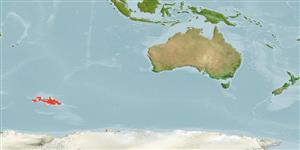Environment: milieu / climate zone / depth range / distribution range
Ecology
Marine; bathydemersal; depth range 380 - 1010 m (Ref. 30823), usually 600 - 700 m (Ref. 11892). Deep-water; 48°S - 52°S
Southern Ocean: Kerguelen, Skif Seamount (SW of Kerguelen) and off Heard Island.
Size / Weight / Age
Maturity: Lm ? range ? - ? cm
Max length : 12.6 cm TL male/unsexed; (Ref. 44814)
Short description
Identification keys | Morphology | Morphometrics
Dorsal soft rays (total): 53 - 58; Anal soft rays: 48 - 53; Vertebrae: 59 - 64. This species is characterized by the following: broad head; ventral and transverse mouth; smaller chin pores than mandibular pores and markedly approximated; opercular opening do not extend below 2nd and 3rd pectoral-fin rays; operculum about 1/3 HL; very large opercular lobe, extending far past of pectoral; rays of pectoral fin evenly decreasing in length without forming marked notch. Colour of peritoneum black, stomach dark brown to black (Ref. 44814).
A 1.45 cm SL fry was caught in the mesopelagic zone (Ref. 44814).
Life cycle and mating behavior
Maturities | Reproduction | Spawnings | Egg(s) | Fecundities | Larvae
Stein, D.L. and A.P. Andriashev, 1990. Liparididae. p. 231-255. In O. Gon and P.C. Heemstra (eds.) Fishes of the Southern Ocean. J.L.B. Smith Institute of Ichthyology, Grahamstown, South Africa. (Ref. 5196)
IUCN Red List Status (Ref. 130435)
Threat to humans
Harmless
Human uses
Tools
Special reports
Download XML
Internet sources
Estimates based on models
Preferred temperature (Ref.
123201): 1.7 - 2.9, mean 2.3 °C (based on 12 cells).
Phylogenetic diversity index (Ref.
82804): PD
50 = 0.5000 [Uniqueness, from 0.5 = low to 2.0 = high].
Bayesian length-weight: a=0.00525 (0.00237 - 0.01161), b=3.15 (2.96 - 3.34), in cm total length, based on LWR estimates for this (Sub)family-body shape (Ref.
93245).
Trophic level (Ref.
69278): 3.4 ±0.5 se; based on size and trophs of closest relatives
Resilience (Ref.
120179): Medium, minimum population doubling time 1.4 - 4.4 years (Assuming tmax>3).
Fishing Vulnerability (Ref.
59153): Low vulnerability (10 of 100).
